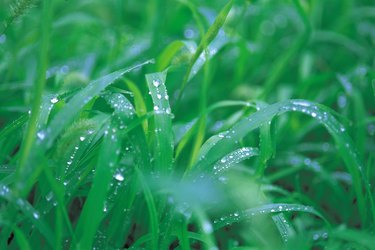
There are plenty of tips about how to grow green grass, and you can do it without using water from a municipal source for irrigation. You don't have to spend a fortune watering your lawn, and you might be surprised to learn that yours can be even greener than your neighbors with the proper methods.
Best Way to Water Grass Without a Sprinkler System
Video of the Day
You can use harvested rainwater to water lawns, saving money, reducing runoff and reducing the impact on your local watershed. It's also safer for grass and plants because it doesn't contain harmful contaminants or minerals like municipal water sources.
Video of the Day
You will need a collection area, transportation system and storage area to get started. You can collect rainwater from places like roofs and awnings and transport it down through gutters and downspouts fitted with filters to keep out unwanted things, like leaves and animals. Collect the rainwater in a plastic barrel designed for this or in repurposed containers, like trash cans or buried cisterns.
Connect a water hose at the base and attach a drip/soaker hose or a sprinkler to the other end. You can even get a timer and put that on to automate your lawn's water. More sophisticated rain barrel systems have sump pumps and PVC or flexible pipes. You can design this yourself or engage a landscaping company to do it for you; either way, it's less costly and more environmentally friendly than sprinkler systems. This is green lawn irrigation at its best.
How to Get Green Grass
Another way to get a green lawn is to use a top-dressing. This is a method that involves applications of compost and other organic matter that will help the grass retain more moisture and keep the root zone cooler in the heat and warmer when it's cold outside. You can make the organic water from humate, worm casings, lava sand and corn gluten meal. There are also moisture-retention teas, humectants and organic fertilizers that can cut down or eliminate frequent watering.
Proper lawn care can also reduce your need to water the grass. Mow it down to about 3 inches instead of to the ground, as the extra tissue in the blades helps with water storage and creates shade to prevent water from evaporating. Core aerating the lawn also helps with water penetration, increases nutrient availability, reduces compaction and improves soil air exchange. This aeration is done with a core aerating machine that you can rent from a home supply or landscaping store that extracts cores of grass, thatch and soil from the ground.
Grass Seed That Doesn't Need Watering
Grass seeds need at least some water to germinate, but certain grass varieties are much more drought-resistant than others. One of the best ones for warm-season climates is zoysia (Zoysia japonica, USDA plant hardiness zones 5-11), which needs just 0.5 to 1 inch to stay thick and green. It can also go dormant for three to four weeks without dying following an extended period of drought. Bermuda grass (Cynodon dactylon, zones 6-9) only needs 1 to 1 1/4 inches of water each week to retain its green color. St. Augustine grass (Stenotaphrum secundatum, zones 7-12) is also drought-resistant.
For cooler climates, Kentucky bluegrass (Poa pratensis, zones 3-7) can do great with just 1 to 1 1/2 inches of water a week and has a recognizable blue-green to bright-green color. Tall fescue (Festuca arundinacea, zones 3-6) is a darker green and survives with 1 to 1 1/4 inches during weekly waterings. Fine fescue (Festuca ovina, zones 4-8) needs even less; it has long roots and only needs 3/4 to 1 inch a week.
- Twin Oaks Landscape: How to Capture and Utilize Rainwater for Lawn Irrigation
- Spriggs Brothers Organics: 9 Things You Can Do to Use Less Water and Have a Green Lawn
- TruGreen: 7 Benefits of Lawn Aeration: Why You Should Core Aerate Your Lawn
- Bob Vila: Solved! The Best Drought-Resistant Grass for Dry Summers